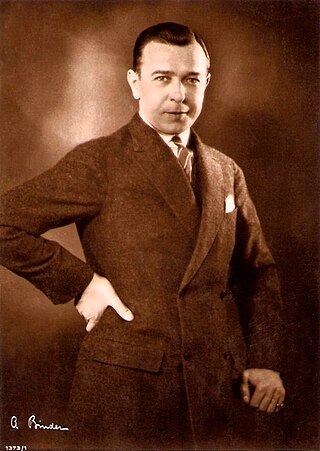| Geschwader Fledermaus | |
|---|---|
| Directed by | Erich Engel |
| Written by | Hans Székely |
Release date |
|
| Country | East Germany |
| Language | German |
Geschwader Fledermaus (Bat squadron) is an East German film. It was released in 1958.

Die Fledermaus is an operetta composed by Johann Strauss II to a German libretto by Karl Haffner and Richard Genée, which premiered in 1874.

A flight is a small military unit within the larger structure of an air force, naval air service, or army air corps; and is usually subordinate to a larger squadron. A military aircraft flight is typically composed of four aircraft, though two to six aircraft may also form an aircraft flight; along with their aircrews and ground staff. In some very specific examples, typically involving historic aircraft, a flight may contain as many as twelve aircraft, as is the case with the Battle of Britain Memorial Flight (BBMF) of the British Royal Air Force (RAF). In most usages, two or more flights make up a squadron. Foreign languages equivalents include escadrille (French), escuadrilla (Spanish), esquadrilha (Portuguese), patrulă (Romanian), zveno (Russian), and Schwarm (German).
In military aviation, a wing is a unit of command. In most military aviation services, a wing is a relatively large formation of planes. In Commonwealth countries a wing usually comprises three squadrons, with several wings forming a group. Each squadron will contain around 20 planes.
A group is a military unit or a military formation that is most often associated with military aviation.

The German language term Stab was used during World War II to designate a headquarters unit of the German Luftwaffe. There were Stab units at the level of a Gruppe or Geschwader – units that were equivalent to wings and groups in the air forces of the English-speaking world. Stab units directly controlled aircraft as well as controlling those belonging to subordinate units.

Between 1933 and 1945, the organization of the Luftwaffe underwent several changes. Originally, the German military high command, for their air warfare forces, decided to use an organizational structure similar to the army and navy, treating the aviation branch as a strategic weapon of war. Later on, during the period of rapid rearmament, the Luftwaffe was organized more in a geographical fashion.
Gruppenkommandeur is a Luftwaffe position, that is the equivalent of a commander of a group or wing in other air forces. A Gruppenkommandeur usually has the rank of Major or Oberstleutnant, and commands a Gruppe, which is a sub-unit of a Geschwader. A Gruppe usually consists of three or four Staffeln.
Geschwaderkommodore is a Luftwaffe position or appointment, originating during World War II. A Geschwaderkommodore is usually an OF5-rank of Oberst (colonel) or Kapitän zur See. A Geschwaderkommodore will command a Geschwader (Wing), which in turn contains Gruppen (Groups) each commanded by a Gruppenkommandeur.

Jagdgeschwader 53 was a Luftwaffe fighter-wing of World War II. It operated in Western Europe and in the Mediterranean. Jagdgeschwader 53 - or as it was better known, the "Pik As" (Ace of Spades) Geschwader - was one of the oldest German fighter units of World War II with its origins going back to 1937. JG 53 flew the various models of the Messerschmitt Bf 109 throughout World War II.

Franz Friedrich Richard Genée was a Prussian-born Austrian librettist, playwright, and composer.
A Ergänzungs-Jagdgeschwader (EJG) were Luftwaffe replacement training units which were part of a larger operational Jagdgeschwader. The Germans were sometimes forced to undertake operations and training simultaneously. In 1944, the Luftwaffe formed two of these units, EJG 1 and EJG 2, by combining various training and experimental units. Its commanders included Viktor Bauer and Werner Andres.
Lehrgeschwader 1 formerly Lehrgeschwader Greifswald was a Luftwaffe multi-purpose unit during World War II, operating fighter, bomber and dive-bomber Gruppen. The unit was formed in July 1936 and operated the Messerschmitt Bf 109, Messerschmitt Bf 110, Dornier Do 17, Heinkel He 111, Junkers Ju 88 and Junkers Ju 87.

Ulrich Neckel Pour le Mérite, Iron Cross First and Second Class, was a World War I fighter ace credited with 30 victories.

Erich Gustav Otto Engel was a German film and theatre director.

Georg Alexander was a German film actor who was a prolific presence in German cinema. He also directed a number of films during the silent era.
János Székely was a Jewish Hungarian writer and screenwriter. His best-known work is the 1949 autobiographical novel Kísértés (Temptation).
Jagdgeschwader 234 was a fighter wing of Nazi Germany's Luftwaffe in World War II. It operated during peacetime and conducted formation flying, simulated aerial combat, and firing on ground targets. Many of its pilots came from Jagdgruppe 88 operating in Spain during the Spanish Civil War.
Hans-Jürgen Degenhardt was a German songwriter, actor, director and author. He was considered a successful German writer of musical comedies.